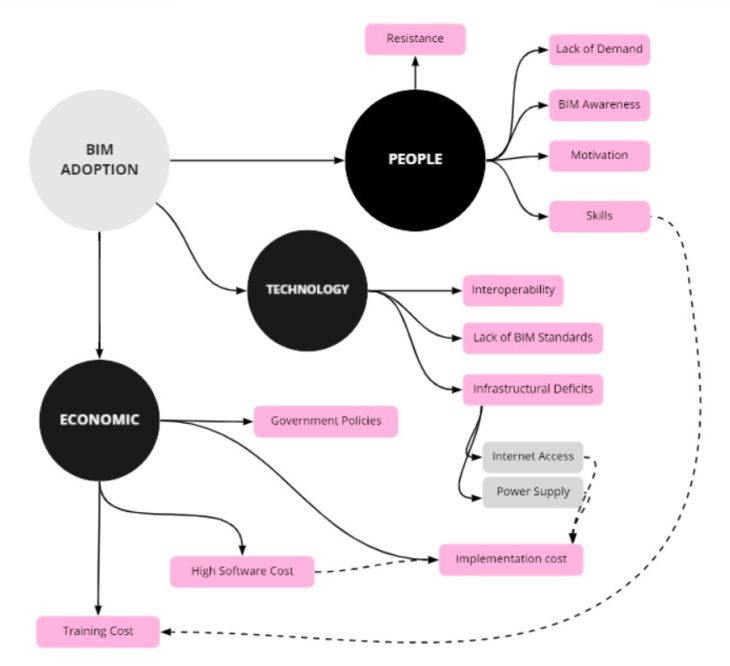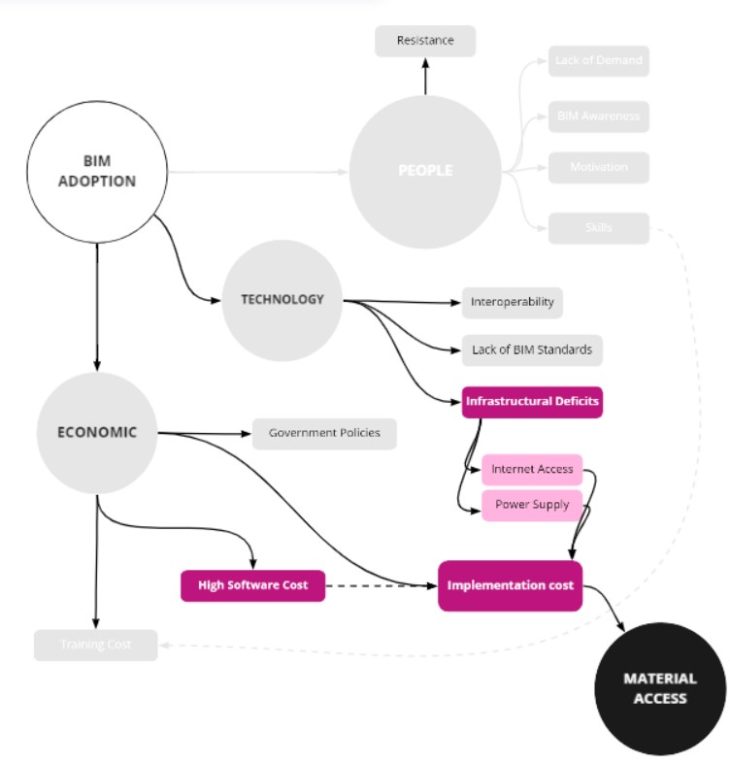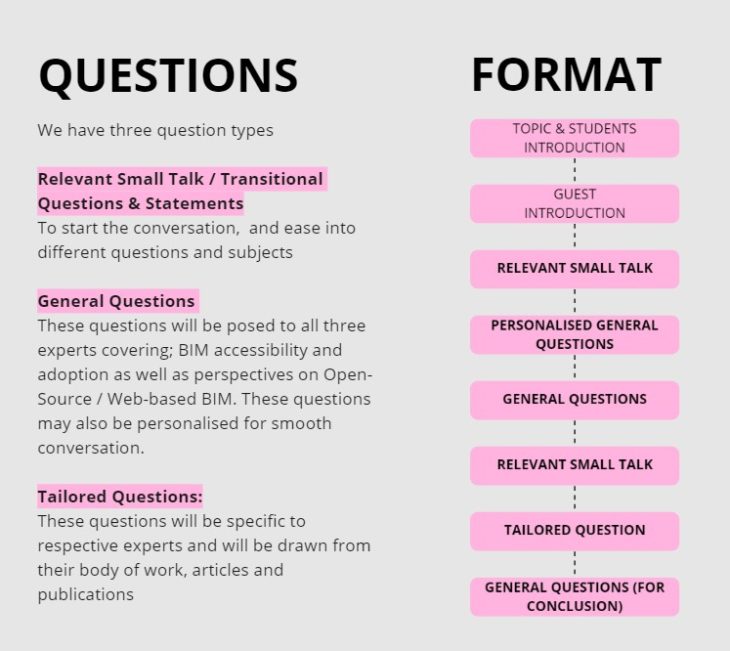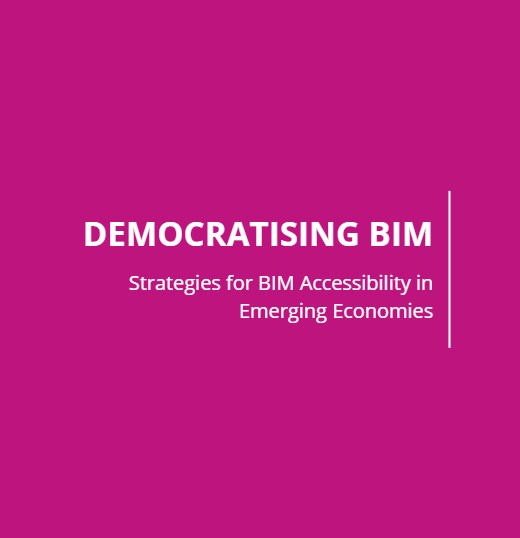Accessibility is one of the main barriers to BIM adoption in emerging economies. The high cost of cloud-based BIM software, such as Autodesk Revit, and limited technological infrastructure place BIM out of reach of many AEC professionals. What strategies can reduce software and BIM investment costs? Can open-source or web-based BIM platforms such as Autodesk viewer and Hypar break the cost and technological barriers to democratising BIM in emerging economies? This study provides three perspectives on these questions- global, contextual and technological- and seeks potential and plausible solutions to BIM accessibility. Using podcasting as a research methodology, three subject-matter experts share their professional experiences and knowledge on the topic. This study further analyses and compares these perspectives to conclude on the state of BIM adoption in emerging economies and the role of technology in its promotion.
BACKGROUND
Building Information Modeling (BIM) has augmented the building industry by enabling collaboration among project teams. When implemented effectively, BIM can contribute to project savings, and increase productivity, thereby promoting economic growth and more sustainable designs. The recent increase in the adoption of BIM globally triggered several pieces of research and studies on BIM implementation, adoption and challenges. Many of the studies on adoption showed that while BIM continues to be implemented in developed countries, adoption in developing countries is relatively slow for several reasons.
Low implementation in developing countries can be attributed to substandard technology, unfavourable economic climates, substandard BIM systems and negative attitude to BIM in the construction sector in China (Zhang et al, 2020). Arroteia et al (2021) contend that a misunderstanding of BIM concepts, low skill and training, lack of digital materials and infrastructure, resistance to new technologies and high cost of and a lack of access to BIM software are the main difficulties related to BIM implementation processes in a case-study project in Brazil.
In trying to identify these challenges, researchers often generalise reasons for low adoption; data collected and reviewed for a location are often used to represent the whole. Saka et al (2019) commented that while these reviews are extensive and informative, they often adopt a singular and global view of BIM development and often do not reflect the variances in the level of growth, but rather present a holistic status quo of BIM research. In Africa, for example, BIM is still in its infancy, and research on BIM adoption only dates back to 10years. Measuring BIM adoption against global standards and local-global data representation in research leads to generalisations; while valid in some contexts, they are not always representative of BIM adoption levels and barriers in different countries.
Contextual nuances (“Contextuality“) have strong local influences on the deployment of BIM. Factors such as government and geopolitical structures, economic structure, infrastructural development and informal economy component vary in different locations and can be significant determinants of BIM uptake in these locations. As such, BIM adoption and implementation levels vary from country to country, discipline to discipline, and client to client (Gu & London, 2010). While keeping a global perspective on the subject, this research narrowed to specific geographical locations (West Africa) for contextual review, referencing two cities, Accra-Ghana and Lagos-Nigeria, which are the two major contributors to the AEC industry in the region.
FRAMEWORK

INITIAL FRAMEWORK_ Economic, Technology and People Barriers to BIM Adoption
In the meta-synthesis of available research on BIM in Africa, Saka & Chan (2019) classified barriers to BIM adoption into three categories: People-related, Economic-related and Technology-related factors. People-related challenges consist of low skill level, motivation and BIM awareness, lack of demand by clients and resistance to technology. Economic factors encompass high software, implementation and training cost and a lack of policies and regulations on BIM. Technological factors cover Interoperability, lack of BIM standards and infrastructural deficits that drive up implementation costs. The study further revealed that people-related factors are most severe in limiting BIM adoption in Africa and must be checked to promote the proliferation of BIM in the AEC industry. When appraised simultaneously, economic and technological factors point to a fundamental challenge – material access – that we consider more important for BIM adoption. To have motivation, skills, spread awareness, or form any opinion that may instigate a positive cultural shift towards BIM, people need to engage with the software. Additionaly, Landisky, V. (2016) suggests that the main barriers are resultants of financial and infrastructural limitations. Purchase and maintenance costs of software licenses are disproportionately burdensome for small firms, individuals and projects. Similarly, IT infrastructure and set-up costs are also limiting to BIM implementation.

REVISED FRAMEWORK_Material Access as the main barrier to BIM adoption
Furthermore, BIM Adoption of BIM is related to governmental policy. The surge in BIM adoption in the UK, US and Singapore is related to government enforcement of the use of BIM on public projects. The top-down approach, while successful in developed countries, will require, beyond enforcement, infrastructure to give material and physical access to the software and incentives for usage. A bottom-up approach may be a better way. In economies where people and private corporations provide their infrastructure, empowerment may be key to ensuring affordability and participation. Additionally, the AEC industry in developed economies has a large informal economy component, a part of the economy that is not regulated and is not taxed. These informal components are mostly Small and Medium Enterprises (SMEs) – artisans, building services professionals and local crafters who do not have access to BIM platforms. With the rise of social media, many SMEs have leveraged these platforms for marketing and business transactions. This shows that technology and the internet hold promise and Web-based such as Autodesk viewer, and open-source applications, like Hypar and Speckle, may open a new market allowing participation of this component and consequently improvement in BIM adoption.
THESIS STATEMENT
Material and physical accessibility is one of the main barriers to BIM adoption in emerging economies. The high cost of cloud-based BIM software, such as Autodesk Revit, and limited technological infrastructure place BIM out of reach of many AEC professionals. What strategies can reduce software and BIM investment costs? Open-source and web-based platforms such as Hypar and Speckle offer more BIM functionality than web-based viewers, such as Autodesk viewer, and seem promising for accessibility, especially for the informal economy. How can such platforms be optimised to meet the needs of small and mid-scale practices and young AEC professionals in emerging economies? Can these platforms break the cost and technological barriers to democratise BIM in emerging economies? Additionally, is large-scale BIM accessibility via web-based platforms enough to surmount contextuality to instigate a cultural shift towards embracing BIM beyond 3D and also promote standardisation in the AEC industry in emerging economies? What future developments/improvements can BIM bring to the AEC industry in emerging economies, especially towards promoting contextual architectural identities?
METHODOLOGY
This study uses podcasting as a research tool to gather information and insights on the subject. Subject-matter experts were invited to share insights and information from their professional experiences and research. For a holistic view of the subject, and to cover all aspects of our thesis statement – global, contextual and technological, we interviewed three experts for a three-part podcast series.
Guest 01 (Global) – Adam Matthews
Guest 02 (Contextual) – Abdullahi Saka
Guest 03 (Technology) – Ian Keough

Adam Matthews MBA MBCS is the Head of International at the Centre for Digital Built Britain (CDBB) and the UK’s Construction Innovation Hub; Chair of the Global BIM Network and former Chair of the EU BIM Task Group (2015-2018). Adam advises governments and national committees on policies and strategies to advance the digitalization of the construction sector. He has consulted on national innovation programs with over 40 countries and multi-lateral organisations across Europe, Latin America, North America and Asia. With over 30 years of experience in information technology, strategy and change management across the built environment, Adam co-authored the UK Government’s BIM Strategy (2011) and designed the UK’s international BIM program methodology (2017). He Chaired the EU BIM Task Group (2015-2018) and was the lead author of the EU BIM Task Group’s 2017 Handbook for the Public Sector introduction of BIM. He holds a BSc in Decision Sciences, an MBA in construction sector policy and sustainability; and is a doctoral researcher at Cranfield School of Management connecting public policy and digitalization.

Abdullahi Saka is the Lead for the Research and Development Committee of BIM Africa, a Pan-African community of construction professionals and researchers digitizing the African Built Environment. He is currently a PhD student at the Department of Building and Real-Estate (BRE) at The Hongkong Polytechnic University and an Associate Member of the Hong Kong Institute of Project Management (AHKIPM).
His current research focuses on Small and Medium-Sized Enterprises (SMEs) in Developing countries where SMEs are the backbone of the economy and vital to the country’s development. Specifically, the adoption and implementation of Building Information Modelling(BIM)in the Construction of Small and Medium-Sized Enterprises (SMEs) in Developing Countries. It involves developing a dynamic model for the firms towards sustainable adoption of BIM at the organization level and the development of a hybrid intelligent system for such firms at the project level.

Ian Keough is the co-founder of Hypar. Ian’s early work at Buro Happold identified a need for mobile applications to leverage BIM data. His software goBIM, for the first generation iPhone and iPad, was acquired by Vela systems for use in their Vela Field product, which would later be acquired by Autodesk and become BIM 360 Field.
While in Autodesk, his open-source visual programming language Dynamo would grow to attract a worldwide community of AEC software developers. In 2017 Ian left his position as the software architect for the AEC Generative Design group in Autodesk to start Hypar with the mission to unlock the world’s AEC expertise to generate better buildings. Ian has a Bachelor of Fine Arts degree from the University of Michigan and a Master of Architecture degree from Parsons School of Architecture.
INTERVIEW SETUP AND SCRIPT.
We set out to have a conversational interview for better engagement and the interview script was set up to ensure a smooth transition between questions and also allow for off-script conversation.

INTERVIEW SET UP_Questions and Format
GENERAL QUESTIONS
- Informal economy in the AEC industry. Contextual nuances and the informal sector play a critical role in BIM adoption in developing countries. How will the informal economy benefit from integrating BIM properly?
- Software and Investment costs as a barrier to BIM adoption. What are the contributing factors to high software and upfront costs? Are parallel market rates, software optimisation and localisation, and government subsidy considered potential solutions?
- Web-based viewers, such as Autodesk Viewer, seem promising for accessibility, especially for the informal economy; however, a lack of widespread and consistent internet access is a limiting factor. What is the minimum level of infrastructural development needed to improve access to web-based BIM platforms?
- Open-source and web-based platforms such as Hypar and Speckle offer more BIM functionality than web-based viewers. How can such platforms be optimised to meet the needs of small and mid-scale practices and young AEC professionals in emerging economies?
- Is large-scale BIM accessibility via web-based platforms enough to surmount contextuality to instigate a cultural shift towards embracing BIM beyond 3D and also promote standardisation in the AEC industry in emerging economies?
- What future developments do you see BIM bringing to the AEC industry in emerging economies?
TAILORED QUESTIONS
Guest 01: The aim was to understand levels of BIM adoption and barriers to implementation from a wider and global perspective. We wondered if our guest would give a different perspective on measuring BIM implementation in developing economies and also wanted to clarify governmental roles and strategies in promoting BIM adoption. Therefore, our questions were centred on barriers to BIM adoption, the role of government and national committees in BIM accessibility, policies and strategies for BIM implementation and strategies by International BIM bodies to promote participation and engagement in developing economies.
Guest 02: We set out to understand how contextuality plays into BIM adoption. We also sought to address access as the main barrier and how it affects BIM adoption, especially in the African context. We were also curious about how BIM adoption should be measured in developing economies. Given that many developing countries are relatively new to BIM, compared to their developed counterparts, should the same metrics apply? Furthermore, how will improvement in BIM adoption affect architectural identity locally? We also wanted to hear how the informal sector (SMEs) in the African AEC industries benefit from BIM, and potential solutions to promote accessibility, especially for SMEs and young professionals.
Guest 03: For our third guest, our curiosity was about technology and its potential to promote accessibility. From our guest, we hoped to learn if software costs could be reduced at every stage in software development and distribution. With the wave of successful startups emerging in Africa, we wondered and posed if a startup model for AEC technologies would drive infrastructural developments and facilitate software cost reduction through local production and consumption?
FINDINGS
BIM definition: We specifically asked each of our guests their definition of BIM. Clarifying their definition of BIM will give a better understanding of their perspective on the topic. Guest 01 emphasised the need for clarity at national and global levels as it makes it easier to implement BIM down the line. He expressed BIM as Better information Management: using the information to make better decisions across the construction and asset lifecycle of a project. Guest 03 felt concerned that BIM is often limited to software, and this could be a reason why true BIM adoption is slow. Beyond software, he defines BIM as an entire toolchain required to achieve the desired outcome using data and processes with an intelligent model at its core. Guest 02’s definition ties both perspectives together, expressing BIM as the intersection of technology, people and process.
Level of Implementation in Developing Economies: All three guests agreed that BIM adoption in developing economies was low. Guest 03 described the use of BIM (software) as spotty and 2D CAD software is more widely used. Guests 01 and 03 explained what qualifies as ‘developing’ economies. Guest 01 chose to describe according to the level of income and classified countries as either middle-income or low-income economies. The level of BIM adoption in middle-income countries like Chile has been on the increase while lesser progress has been made in lower-income countries. Guest 02 had a similar perspective and expressed that level of BIM adoption should be contextualised. Citing examples of China and Nigeria; China is often considered a developing economy; however, the level of adoption is far higher than in many other developing economies. He further clarified that while BIM adoption levels in emerging economies may be measured against global standards, they should not be compared against developed economies. Such comparisons are not only unfair, but they are also usually a basis for misrepresentation.
Barriers to BIM Adoption: Guest 01 posed that while accessibility is a substantial challenge to BIM implementation, there are other equally or more important challenges such as lack of underlying digital infrastructure, a lack of demand for BIM, and low skill and awareness levels. Guest 02 and 03 both agree that a lack of material access is a major and perhaps the most significant barrier. According to Guest 02 BIM is “too expensive, too out of reach, too hard to train up the small numbers of employees…”. Guest 02 explained that infrastructural, software and hardware access poses a serious challenge. The high cost of subscriptions makes it difficult for small firms and professionals to purchase the software. He also echoed points from Guest 01 expressing skills access and usage opportunities as other important reasons for low BIM adoption in these countries.
Possible solutions: All guests had various recommendations to promote accessibility and BIM uptake. Common Suggestions include:
- Government: Alongside partnering with industries, government plays an active role in promoting BIM accessibility and adoption by creating and fostering fertile environments, and policies and enriching innovation systems for industries to thrive. Governments can give software subsidies, or voucher systems as implemented in Singapore, to reduce the financial burdens of BIM investment on small and medium enterprises. As the biggest spenders and largest single public client, governments can progressively increase demand for BIM and consequently, its supply; and also introduce digital ways of working and digital skill transfer across locations by introducing BIM in the syllabus in Universities and colleges and establishing national networks of digital centres.
- Software: Companies may offer reduced pricing systems to developing economies. Open-source platforms are viable alternatives for costly cloud-based software. As open-source, their pace of development is slow, as such, may benefit from low-cost subscriptions to fund development while keeping costs to the user as minimal as possible. Buildings are hyper-local and promoting local software or creating libraries for existing platforms may contextually refine many BIM platforms with contents for local use. Furthermore, companies have to do more to promote awareness and the benefits of their software in developing economies. Student engagement through free licenses and free training and workshops for students targeting universities in developing economies will promote awareness and skill development in the long term.
CONCLUSIONS
At the onset of this research, we wanted to understand the reasons for the low level of BIM adoption in emerging economies. We theorised that material access may be the greatest challenge to democratising BIM and wondered if open-source and web-based applications would break the technological barriers to accessibility. During the course of our research through podcasting, we have learnt that although material access may be the biggest barrier to adoption, it can not be addressed in isolation from other challenges such as demand for BIM, low skills and awareness levels. Furthermore, the recent successes of fintech startups coming out of Africa and the use of social media by the informal economy indicate that accessible technology promotes innovation and industry in these resilient economies. However, reflecting on the words of Architect, Cedric Price, “Technology is the answer, but what was the question?”, one is reminded to not be presumptuous that technology solves all problems. Open-source and web-based platforms will provide access, especially to the informal economy and lowering software costs will promote accessibility for small firms and professionals; however, there is a need to contextualise/localise content and processes to suit the dynamics in many developing economies.
REFERENCES
- Zhang, R., Tang, Y., Wang; L., and Wang, Z. (2020) Factors Influencing BIM Adoption for Construction Enterprises in China
- Buiab, N., Merschbrockb, C., and Munkvolda, B.E.,(2016) A review of Building Information Modelling for construction in developing countries
- Saka, A.B., Chan, D.W.M., M.ASCE2, and Mahamadu, A. (2021) Rethinking the Digital Divide of BIM Adoption in the AEC Industry
- Saka, A.B., Chan, D.W.M. (2019) A Scientometric Review and Meta-synthesis of Building Information Modelling (BIM) Research in Africa
- Arroteia, A.V., Freitas R.C., and Melhado (2021) Barriers to BIM Adoption in Brazil
- BimAfrica.org
- Ladinski, Vladimir. (2016). Re: What could be the barriers to incorporating BIM practices in construction projects in developing countries?. Retrieved from: Researchgate
- Noor Akmal Adillah Ismail, Maria Chiozzi1, and Robin Drogemuller An Overview of BIM Uptake in Asian Developing Countries
- Afza, Z., Understanding BIM Acceptance In A Developing Country Context: The Case of Bangladesh’s First BIM Consultancy
- Gu, N., London, K.(2010) Understanding and facilitating BIM adoption in the AEC industry. Autom. Constr.
19, 988–999. [CrossRef]
Democratising BIM: Strategies for BIM Accessibility in Emerging Economies is a project of IAAC, Institute for Advanced Architecture of Catalonia developed in the Master in Advanced Computation for Architecture & Design 2021/22 by Students: Oluwadamilola Akinniyi and Amanda Gioia |Faculty: Dr Maite Bravo
